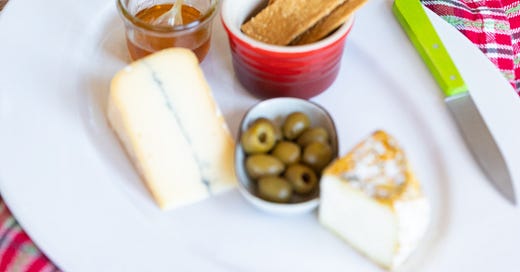Hello! If you are just picking up the Grape to Table newsletter, thanks so much for joining to learn more about wine, food, and life. We have just wrapped up my origin story (click here to read), and we are diving into fun content focused on meaningful time at the table with delicious wine and food.
Okay it’s the one month of the year when I can talk Champagne for days on end – hallelujah! I do understand the issue with Champagne beyond the holiday season is that it’s pricey (and you need a primer to read the labels!).
Well, what if I told you that the price is mostly related to the complex process and unique growing conditions behind this famed sparkling wine. And yes, both these factors indeed add complexity to the wine! So, yes, it’s worth the splurge!
And what if I give you the primer right here? Just promise to treat yourself to a bottle of real deal Champagne sometime soon!
Champagne Primer:
Firstly, Champagne is a region in northern France, and technically any bottle labeled Champagne must come from this region. It is a cool climate region (at the northerly limits of grape growing) and located on an ancient seabed that has created magical chalk soil. The climate and soil are two key factors in the loveliness of Champagne (versus quality sparkling from other regions).
Second, there is a lengthy process that creates Champagne. It starts off as a still wine but then is bottled with a bit of sugar and yeast to ignite a secondary fermentation in the bottle. This creates the bubbles, and Champagne remains in contact with the yeast for quite a while giving it that trademark buttery pastry quality.
One of the last steps in the Champagne process is the beautification – i.e. removing those murky yeasts – in a process known as disgorging. You lose a little wine in this process and so it is necessary to top off the bottle before corking. You can top off with wine or with wine mixed with a bit of sugar, which determines the Champagne’s final taste profile. You see appropriate labeling on the bottle. Brut Nature designates no sugar. Next levels up are Extra Brut and Brut, which are still quite dry. Beyond this, Extra Dry and up has some sweetness.
Other labeling terminology will point to grapes. The three star grapes of Champagne are Chardonnay, Pinot Noir, and Pinot Meunier (now usually referred to as simply Meunier.) There are four other allowed grapes, but they are rarely seen.
When a Champagne is made from all white grapes it is labeled as Blanc de Blancs; when a Champagne is made from all red grapes it is referred to as a Blanc de Noirs. (But note that despite the red grapes – most Champagne is vinified white! Yep, it’s possible to make white wine from red grapes. More on that in another newsletter).
Moving onto another factoid: most Champagne is non-vintage and will be listed as NV on a restaurant wine list, but in the very best years producers will make vintage Champagnes. This is a tradition that is changing a bit with some younger generations choosing to make vintage Champagne every year to capture the essence of that year. (But let’s save that deep dive for your Champagne 2.0 Primer!)
Fancy names like Dom Perignon and Cristal are actually vintage Champagnes from houses you have probably heard of – Moet & Chandon and Roederer, specifically.
Speaking of the big houses – like Moet, etc. – these ruled the Champagne trade in near totality until more recent times when small “grower-producers” began making Champagnes from their own grapes. (Most big houses have traditionally bought grapes from small farmers around the region.)
While I am not here to cast stones at the big houses, I have to admit that I am a huge proponent of these smaller, grower Champagnes. With many of the growers there just seems to be an added layer of complexity. Plus, I do just love supporting smaller producers. Of course, the issue is finding grower Champagne in smaller markets. But it’s worth a trip to your local wine shop for a chat!
Most importantly find a Champagne that speaks to you and promises to add some magic to your holiday season.
P.S. If you happen to take a close look at the above photo you will notice I am actually pouring into a “regular” white wine glass (not a flute). Many wine nerds (and restaurants) prefer this as you can really smell (and therefore taste) more. Many flutes are just so narrow it can be difficult to catch all that’s going on. Now, don’t get me wrong I still have a set of flutes, AND I think Champagne saucers are super cute. So you do you, but just so you know the wine nerd thinking…
P.P.S. Don’t forget that you can see all past newsletters by clicking here.






I just did a champagne tasting and I got a question, that I could use some help. Talk about the size of the bubbles and why the smaller the bubble are sought after.